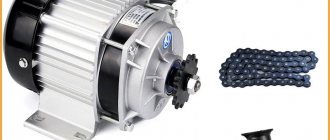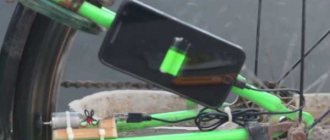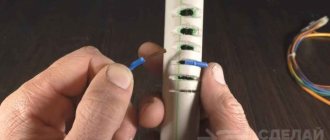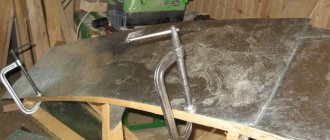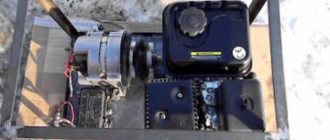Register Login
Publication date: September 6, 2019
In 1994, all residents of Mendocino County on the California coast vied with each other to discuss the invention of local craftsman Larry Spring. A small motor suspended in the air miraculously rotated by itself and did not require a power connection. Standing on the windowsill of a small shop, the mysterious engine invariably became the subject of close attention of children and adults. Attempts to unravel the master’s secret were unsuccessful until Larry himself admitted to the most persistent visitors what secret he based his invention on.
Everything turned out to be very simple. The ability to adjust the laws of physics to each other and a little ingenuity allowed Spring to design a small engine, the main elements of which are a rotor and a stator - everything, like “real” motors. However, here lies the main secret. A stand with a permanent magnet and a magnetic support is used as a stator. And the role of the rotor is performed by a dielectric frame with a set of solar panels mounted on top of the rotating coils.
The principle of operation of the engine is based on the rotation of the rotor under the influence of magnetic fields arising from the passage of electric current through the coils of the device. The necessary charge is supplied to the motor thanks to the operation of solar panels. Receiving power in turn, the coils are “pushed” away from the emerging magnetic field due to the Ampere force. But, since they are fixed on magnetic supports, the rotation process starts. This is exactly how any low-power magnetic levitation motor operates, such as the Mendocino engine.
DIY Mendocin motor: secrets of the American Kulibin
Date of publication: September 6, 2019
In 1994, all residents of Mendocino County on the California coast vied with each other to discuss the invention of local craftsman Larry Spring. A small motor suspended in the air miraculously rotated by itself and did not require a power connection. Standing on the windowsill of a small shop, the mysterious engine invariably became the subject of close attention of children and adults. Attempts to unravel the master’s secret were unsuccessful until Larry himself admitted to the most persistent visitors what secret he based his invention on.
Everything turned out to be very simple. The ability to adjust the laws of physics to each other and a little ingenuity allowed Spring to design a small engine, the main elements of which are a rotor and a stator - everything, like “real” motors. However, here lies the main secret. A stand with a permanent magnet and a magnetic support is used as a stator. And the role of the rotor is performed by a dielectric frame with a set of solar panels mounted on top of the rotating coils.
The principle of operation of the engine is based on the rotation of the rotor under the influence of magnetic fields arising from the passage of electric current through the coils of the device. The necessary charge is supplied to the motor thanks to the operation of solar panels. Receiving power in turn, the coils are “pushed” away from the emerging magnetic field due to the Ampere force. But, since they are fixed on magnetic supports, the rotation process starts. This is exactly how any low-power magnetic levitation motor operates, such as the Mendocino engine.
Types of products
The levitating photo frame consists of external and internal contours. The outer one contains guides and magnets that focus their field. In the inner one is the magnet of the top itself. One or two photographs are inserted into the inner outline itself. Rotating, the top outline shows the front and back sides of the inserted photos. A frame with such a device can effectively decorate a table. For example, a gamer who enjoys popular online games places two photographs of one or two favorite characters facing in both directions. The inner contour of such a photo frame is made, for example, in the shape of a heart, symbolizing love and sympathy for these fictional characters. And if he gets caught in the image from a webcam while streaming, the gamer will stand out with this “trick” and attract the attention of new subscribers to his own video channel. In other cases, a levitating photo frame becomes a piece of furniture for a room or a decoration for the home.
The levitating dish stand includes a top magnet built into the bottom of, for example, salad bowls or flower vases. However, asymmetrical handles on utensils, for example, on a liter saucepan for preparing first courses for one person or a frying pan, will unbalance the top.
The piece of utensil will turn over, being pulled and knocking the prepared dish onto the table.
The sound column must be round, homogeneous, powered by an on-board battery, and be wireless, for example, a sound-reproducing speaker with Bluetooth. All details are carefully balanced by a balanced layout. When operating on “bass” vibration feedback, the speaker vibrates while floating in the air.
Other gifts and souvenirs: a watch with a top view of the dial, a glass or mug with a shifted center of gravity (due to the presence of a handle on the side), a flower pot, a small tree as a souvenir, a mini-tree made like a bonsai. As well as an artificial moon (a yellowish ball with a lunar surface texture), a round decorative mini-shelf and other gifts must be carefully centered. The slightest imbalance of the center of mass can turn the Levitron into an incomprehensible-looking object, attracted by the “wrong” side and standing crookedly.
The same applies to voluminous objects that have retained their lightness in terms of their total mass. For example, it could be a decorative cloud with multi-colored LED lighting, an original figurine in the form of a foam snowman with a painted face, and much more.
We assemble a Mendocino motor with our own hands: a detailed examination of the design
The secret of the American inventor opened the opportunity for thousands of home craftsmen to construct a similar device at home in order to impress their relatives and surprise lovers of the mysteries of nature. However, before getting to work, it is worth considering the device in detail. Every centimeter counts here - it is important that all elements are in their place and interact strictly within the framework of physical laws.
The rotor of the Mendocino engine has a square cross-section and is located horizontally in the device. This solution allows solar panels to be placed on its surface. Permanent ring magnets are attached to the ends of the rotor shaft. Thanks to the magnetic field they create, the rotor starts to move, which even the force of mutual friction of the metal elements is unable to stop.
To keep the rotor suspended, magnetic shaft rings are positioned directly above magnetic stands. Another magnet under the rotor is needed to create a magnetic field of the stator, which gives a “start” to the rotation of the rotor.
When sunlight hits one of the solar panels, an electric current is generated. It is sent to the rotor winding, which is located near the magnet directly under the axis. A magnetic field is created at the corresponding pole of the rotor, and the latter begins to rotate, pushing away from the magnetic field of the stator. Sunlight alternately hits each of the solar panels on the four sides of the axis, triggering a similar process in relation to each of the coil windings. This ensures constant rotation of the rotor in its “suspended” state. The device will work properly in the presence of an intense or medium luminous flux.
And the last secret that you need to know before you start manufacturing and assembling a Mendocin motor according to the diagram. Permanent magnets in the rotor suspension are a mandatory design element, thanks to which it is possible to overcome the resulting friction force. Otherwise, the engine power will not be enough, and rotation will stop after the first revolutions.
>Buy as a gift or order a unique item
SHARE WITH YOUR FRIENDS!
- DIY garden lamp— 03/30/2020
- Do-it-yourself mini sauna on a personal plot— 03/28/2020
- Do-it-yourself dollhouse— 03/24/2020
- DIY “Alien Abduction” Lamp— 03/23/2020
- Emergency stock of non-perishable food products—03/22/2020
- How to make a bicycle trailer without welding with your own hands— 03/22/2020
- Do-it-yourself waterproof fire ignition—03/21/2020
- DIY children's washing machine— 03/20/2020
- DIY board game “Dodgeball”— 03/18/2020
- DIY camp cutlery set— 03/15/2020
- Kalimba - a musical instrument made from garbage with your own hands— 03/14/2020
- DIY decorative arched tunnel— 03/13/2020
- Assembling a first aid kit with your own hands—03/11/2020
- DIY furniture made from pallets— 03/08/2020
- Do-it-yourself table lamp for a canine handler— 03/06/2020
Electric bicycle...Homemade decoration...Programming...How to solder correctly...How to make nickel...Solenoid motor...
- What is a brushless DC motor, how does it work and how does it work?
- Price: 42.99 USD
I chose a toy for myself. Yes, not easy, but educational. I love toys, especially unusual ones. This toy contains a whole handful of interesting “special effects”. It hangs in the air, spins on its own, looks beautiful and is still blown by the wind. What it is? Medosinsky motor))) Freudian clause and paragraph 18 The motor was invented only 22 years ago (in 1994) by the American Larry Spring, and patriotically named it in honor of Mendocino County in California, where he himself was from. Its creation became possible due to the widespread use of solar panels. The Mendocino engine is powered by solar panels and levitates on a magnetic levitation. The motor platform consists of five magnets. Four magnets at the base are responsible for levitation; they interact (repel) with magnets located on the motor shaft. The fifth magnet provides the magnetic field for the rotor. There must also be a limiting side panel against which the engine axis rests. The motor consists of a four-sided (square cross-section) rotor mounted on a shaft. There are four solar panels on the rotor block; one battery on each of the four sides and two sets of windings. Electrical circuit of the rotor Schematic representation of How it works. The rotor levitates on the repulsive forces between the magnets of the shaft and base. When light hits one of the solar panels, it generates an electric current that flows through the rotor windings. This current produces a magnetic field that interacts with the field of the magnet under the rotor. This interaction causes the rotor to rotate. As the rotor rotates, the next solar cell moves toward the light and excites current in the second winding. The process is repeated as long as sunlight falls on the batteries. Let's look at the hero of the review. It arrived in a large bag with a bunch of baby bumps and air bags. But this did not save him from breaking the side panel. The stand is still in protective film. We remove the protective film from the base, glue the side panel with superglue, and begin to figure out what's what. Looks nice. I was very impressed by the neodymium magnets, they are very powerful, and the manufacturer apparently likes them so much that he even made the legs of the base with magnets. Below in the photo you can see a magnet in the form of a cylinder, inside the base, and 2 metal balls on top and bottom. The lower balls act as legs. A ball was placed in the four magnets of the base, from which the motor shaft is repelled. Apparently to demonstrate the behavior of ring magnets. It looks beautiful - there is a magnet and inside, just in the center, there is a ball ☺ When you try to push the ball out, it resists elastically. Here is an illustration of magnetic fields to better understand what is happening. You can conduct experiments with magnetizing the washer to the ball and balancing the magnetic fields. This is what the base with magnets looks like. And here are the rotor windings. Let's still try to start our Mendocino motor. To do this you need to shine a light on it. It was already dark, and I tried to shine a 5W LED microscope backlight on it, the rotor began to swing, but did not rotate, apparently it could not move, the light and power were too weak. After a slight push, it began to spin, faster and faster. The next day I took the engine out into daylight. Here everything went more cheerfully, although there were clouds in the sky. The engine started on its own and spun vigorously. The propeller at the end of the engine shaft began to spin and the slightest breeze blew. I captured the whole thing on video. It became very interesting to know what voltage solar panels produce under the sun. I connected the tester - 576 mV at maximum under the sun. And of course the video. And as a resume. I liked the Medosino motor. I enjoyed playing with him. I’ll definitely take it to my work and put it on the windowsill, let it move the air under the sun and please with its appearance. I think it would be a great thing as a gift for a schoolchild or work colleague. This is an item from the category - you can’t buy it for yourself, but you’ll be glad if you give it as a gift. The product was provided for writing a review by the store. The review was published in accordance with clause 18 of the Site Rules.
Perpetual motion technology has been interesting at all times. That is why many scientists, including ordinary people, are trying to solve the issue of its creation. It is believed that the creation of a perpetual motion machine will produce a world revolution and make its creator a famous and rich man. But it is necessary to take into account that science currently rejects the possibility of its development, because it would have to violate physical laws. Engines of this kind constantly appear on the network, but so far this problem has not been solved.
One of these engines is the Mendocino engine. This invention is often called a solar perpetual motion machine. It has no wires, hoses or other cables through which power is supplied. And if you don’t know how it works, then this engine can be called fantastic. It can rotate just like that and at the same time be in a levitating state. But it's not that simple.
Kinds
The Mendocin engine appeared in 1994 thanks to the efforts of the American Larry Spring. The engine got its name from the area of Mendocino, which is located on the California coast. For a long period of time, this unit was located in the Lari store. After some time, it became very popular among local residents. This was explained simply - the rotor was spinning without stopping, while being practically in limbo.
In the unique design of the Spring engine, the axle rested on the glass thanks to pointed heels. However, modern designs have changed somewhat. Today the axis is literally levitating. On one side, the axis rests only on the air space. Only on the other side does the rotor axis rest against the wall to ensure a balanced position. This design allows the device to operate indefinitely, but subject to one condition - the presence of solar energy.
Device
The Mendocino motor, like most electric motors, includes a rotor and stator in its structure. However, at its core, the unit is not a standard engine. In this case, the stator is a stand that has a permanent magnet, as well as a magnetic support. The rotor is made in the form of a dielectric frame with a set of solar cells.
The batteries are activated when photons from the sun fall on them. Thanks to this, the batteries begin to create electric current. This current is directed to coils that are wound around the rotor. When electric current passes through the coils that surround the rotor, a magnetic field appears. Due to the interaction of this field with the stator field, that is, arising from a permanent magnet, the rotor begins to rotate.
The small device requires only a few watts of power, allowing the rotor to spin quite quickly. However, for industrial units a few watts of power will not be enough; solar cells will be required an order of magnitude larger.
The rotor, which is located on a metal shaft, has a rectangular cross-section and is installed horizontally. As a result, this allows for systematic placement of solar panels. Ring-type magnets are placed at the ends of the shaft. Such a device with lateral magnets ensures levitation of the rotor. At the same time, there is almost no friction here.
During operation, there is a condition where the magnets on the shaft are precisely positioned above the magnetic stands, which allows the rotor to rotate in the air without any interaction. In a number of models, a wall made of glass, wood or metal may be located on one side of the shaft. This is done so that the shaft does not have the opportunity to move to the side.
Principle of operation
The Mendocino motor has the following operating principle:
- The rotor has a rectangular shape, each side of which has its own solar battery. When photons of light are directed toward one of the solar cells placed on the rotor, an electric current is generated.
- The electric current flows into the rotor winding located above the stator magnet. As a result of the appearance of electric current in the winding, a magnetic field is formed, as a result of which the rotor begins to be repelled by this winding from the stator magnet.
- Then the light falls on the next solar panel, due to which an electric current is applied to the next winding. A magnetic field is formed, which also drives the rotor. That is, constant movement is observed: light appears on one panel, electric current is generated, the winding is excited, and the rotor is observed to rotate. And so periodically. And so while the required amount of sun light falls on the panel, the engine will rotate.
- The rotor suspension is carried out using permanent magnets in order to obtain a minimum coefficient of friction. This approach is due to the fact that very little engine power is created. This makes it impossible to overcome a significantly higher friction coefficient. At the same time, the rotor axis can be supported by a wall in order to provide additional stability, as well as an equilibrium state. In this state, the unit is able to function indefinitely, the only conditions being that the installation receives a constant small influx of solar energy.
To be precise, in this installation the coil conductors are pushed out due to the current. Since current is supplied to the coils alternately, they are also ejected alternately. As a result, the Mendocino motor can be called a brushless magnetic levitation solar motor, which has low power.
Application
At the moment the motor is not patented. The main reason is that it has no beneficial use. Such a device will not be able to spin up the generator so that it can fully generate electric current. In theory, hundreds and thousands of such devices could be created so that they generate electric current. However, in practice this will be incredibly expensive and unprofitable. It is much easier to install solar panels on the same area to generate electricity. It will be much easier and more efficient.
You can attach fan blades to the motor so that they rotate and cool the room. But there are also limitations here. It will be possible to hang only decorative blades, which will create a barely noticeable air flow. At the current moment in time, the entire value of the device lies in its brevity, aesthetics, unusualness and ability to levitate. Therefore, today this device is sold by the Chinese as a construction set for educational purposes and as a finished product as an unusual item.
Advantages and disadvantages
The advantages include:
- Unusuality.
- Levitation effect.
- An alternative source of energy, but currently not used.
- Ease of execution.
- Decorative.
The disadvantages include:
- Lack of useful industrial applications.
- Quite expensive.
Homemade Mendocino motor
The Internet is full of instructions and recommendations with which, if desired, you can assemble your own Mendocino motor. If you don’t want to bother too much, you can purchase a ready-made Chinese construction set for assembly. This tabletop construction set can be purchased as a gift for a child.
First you will need to prepare materials and tools. The materials you need to take are:
- Veneer, boards and slats.
- Wooden pin with a diameter of 13 mm.
- Special glue.
- Winding wire with a diameter of 0.28 or 0.3 mm and a minimum length of 30 meters.
- Four special solar panels.
- Two ring magnets.
- Support magnets.
- Magnets for the stator.
First you need to lay out the magnets on the shaft. A wooden pin 25 cm long is used as a base. Ring magnets are fixed to the shaft. The interval between the magnets should be selected so that the “floating” magnet is in a stable position, that is, so that it is held in the air. Having determined the distance, the second pair of magnets is installed. In this case, the magnets must be slightly spaced from the wall in order for levitation to be stable. However, stability will be ensured at the point of contact with the wall.
Next you need to assemble the rotor, which is made of veneer. It needs to be wrapped with copper wire. 10 turns are made in one direction, then 10 in the other direction. The same actions are repeated when crossing the primary winding. Then you need to connect the solar panels. They are attached to the base in such a way as to form a kind of square. The panels are connected to the rotor winding. All that remains is to place the rotor on top of the assembled structure with magnets and direct sunlight to the panel. The resulting Mendocino motor should begin to rotate.
Materials needed to build a DIY Mendocino engine
To work you will need the following set of materials and tools:
- Wooden pin with a diameter of just over 10 mm;
- Hot melt adhesive;
- Veneer for rotor manufacturing;
- Wire for winding coils 0.28 mm in diameter;
- Two ring magnets type RX088;
- Several slats and boards for the base and supports;
- Aluminum for the wall;
- Twelve magnets type RX033CS-N.
The choice in favor of these magnet models is not accidental. They have been tested in practice and are better suited than others for the Mendocino engine, guaranteeing its performance.
Daniel Douglas Hume 19th century levitator
The most famous flying man of the 19th century was Daniel Douglas Hume. The editor of one American newspaper describes his first famous flight as follows: “Hume suddenly began to lift himself off the floor, which was a complete surprise to the whole company. I took his hand and saw his legs - he was floating in the air a foot from the ground. The struggle of a variety of feelings - alternating bursts of fear and delight made Hume shudder from head to toe, and it was clear that he was speechless at that moment. After some time it sank, then soared above the floor again. For the third time, Hume rose to the very ceiling and lightly touched it with his hands and feet.”
Hume later learned to levitate at will. For forty years, he demonstrated his unique art in front of thousands of spectators, including many of the then celebrities: writers Thackeray and Mark Twain, Emperor Napoleon III, famous politicians, doctors and scientists. And he has never been convicted of fraud.
Hume himself described his condition during levitation: “I did not feel any hands supporting me, and, starting from the very first time, I did not experience fear ... Usually I rose vertically; often my arms stretched above my head and became stiff, like sticks, when I felt an unknown force that slowly lifted me above the floor.”
However, Daniel Douglas Hume is far from the only one who has baffled scientists with his levitation. So, in 1934, the Englishman Maurice Wilson, who had trained for many years in the art of levitation using the yogi method, decided to conquer the top of Everest with huge jumps, soaring above the ground. His frozen body was discovered in the mountains the following year. Wilson did not reach the top quite a bit. But the fact that he was able to overcome the most difficult route without special climbing equipment speaks in favor of levitation.
Do-it-yourself Mendocino motor: manufacturing in every detail
The work sequence is as follows:
- A wooden pin about 25 cm long was chosen as the shaft. RX088 ring magnets must be attached to its ends.
- The interval between the centers of pairs of working magnets is calculated. Too large a distance will not keep the engine suspended, while a small gap will lead to instability in the position of the main floating magnet. For a design within the above parameters, the magnets should be placed at a distance of about 75 mm between the central points.
- To prevent the shaft from lifting up while moving under the influence of rotational force, the farthest pair of magnets should be installed a little further from the wall relative to the magnet on the shaft. At this stage of assembly, you can experiment to find the optimal fixing point.
- To ensure the stability of the rotating magnets, two magnetic disks are placed parallel to the axis. The interaction of their magnetic fields will ensure a stable position of the rotating element.
- The rotor structure is made from veneer. The individual elements are glued together using hot melt adhesive.
- After the parts have dried, you can begin winding the coils. Ten turns are made on one side of the shaft, then ten turns on the opposite side. The turns are wound in a similar manner on each of the two remaining surfaces. The number of turns in each coil should be about 1000. After winding, the wires of each coil are marked to track the direction of winding.
- Now you need to connect the solar panels - one for each coil.
A self-assembled Mendocino engine can be used as a visual model to demonstrate the operating principle of any motor. All that remains is to choose a suitable place for it, taking into account the quality of natural light.
Source
Website about DIY inventions
Magnetic levitation. Types and work. Application and features
Magnetic levitation is a technology that allows objects to be lifted into the air using a magnetic field. The word “levitation” itself comes from the English “levitate,” which can be translated as “to soar” or “to rise into the air.” In fact, this physical phenomenon allows one to overcome gravity without the use of jet propulsion or aerodynamics, as is done by airplanes, helicopters and drones.
Why does magnetic levitation occur?
From a physical point of view, levitation is a stable position of an object in a gravitational field. In fact, the force of gravity is compensated by the forces acting on the object, which lift it. At a certain point, these forces are equalized, causing objects to hover. The concept that fits into the word “levitation” in its pure form is unattainable, which has long been a proven fact. In fact, the floating of an object is achieved only by exposing it to a magnetic field. Moreover, the object itself, which hovers in the air, does not have the properties of floating without external influence. He will not be able to do this in absolutely any conditions and at different heights.
The conditions that must be met to implement magnetic levitation may vary. There are several technologies that allow you to achieve the soaring effect:
- Electromagnetic.
- Diamagnetic.
- Superconducting.
- Eddy current.
Electromagnetic
This technology for lifting an object above the surface involves the use of. It is located at the bottom of the device. Light metal objects are placed on it. A photocell is fixed above the electromagnet using a stand. The latter's task is to supply and interrupt power to the electric magnet. If a photocell detects a shadow, it turns the power on or off, depending on its location. This happens at intervals of a fraction of a second.
Making your own Mendocino hover engine
I present to your attention an article on how to assemble an unusual electric motor with your own hands
The motor consists of a rotating shaft, which is supported by magnets mounted opposite each other. Power is provided by solar panels (mounted on a rotating axis), which generate a current that passes through the rotor coils.
It's worth noting that this engine is not very powerful. You can't use it in an electric car. In essence, this is a fun scientific homemade product that clearly demonstrates the principles of operation of most electric motors.
Links
- Quantum levitation performed by Israeli scientists
Wikimedia Foundation. 2010.
- Levitan, Arkady Yulianovich
- Levitina, Irina Solomonovna
See what “Levitation (physics)” is in other dictionaries:
Levitation - Levitation. Lithograph by Louis Figuier. 1887 Levitation (from Latin levitas “lightness, lightness”) is a phenomenon in which an object floats in space without visible support (that is, levy ... Wikipedia
Aristotle's Physics - The Greek philosopher Aristotle (384 BC - 322 BC), a student of Plato, developed many physical theories and hypotheses based on the knowledge of his time. In fact, the term “physics” itself was introduced by Aristotle. Written works... ... Wikipedia
Antigravity - Antigravity is counteraction up to the complete suppression or even exceeding of gravitational attraction by gravitational repulsion. Quite often (especially in science fiction) the term “antigravity” is used incorrectly for... Wikipedia
Mendocino Motor - Mendocino Motor Mendocino Motor (en: Mendocino Motor) is an electric motor with a magnetic levitation rotor, and powered by solar energy. Contents... Wikipedia
Read also
Powder keg and solar gas
Powder keg and solar gas Just a few days after the first manned hot air balloon flight, on the winter morning of December 1, 1783, a new type of hot air balloon took off for the first time from the Tuileries Garden in Paris. Unlike a hot air balloon, a ball created by the famous French
Redheffer's perpetual motion machine
6. Redheffer's perpetual motion machine Philadelphia, a city that has been a major administrative and industrial center of the United States of America from the very beginning of its existence, has become the birthplace of several very remarkable perpetual motion machines. Today at
"Perpetual Motion" Cox
10. “Perpetual Motion” by Cox To a sentimental reader, this book may seem like a kind of chronicle of delusions, a story of unfulfilled hopes, a story about wise men driven to despair, and about fools who turned into charlatans. And yet there was a man who
The engine gets very hot
The engine overheats. Cooling system malfunctions. Weak fan belt tension, wear, slipping. Adjust the fan belt tension by changing the position of the generator. If the tension is low, the belt slips; if it is too high, it will slip excessively.
Engine knocks
The engine detonates. Detonation is the explosive combustion of the working mixture in the cylinders (10 times faster than normal). A shock (detonation) wave appears and the pressure increases significantly. The piston bottom vibrates (a loud metallic knock is heard). Detonation must be done immediately
The engine does not warm up for a long time
The engine does not warm up for a long time. Malfunctions of the cooling system. The thermostat valve is stuck in the open position. The main valve is constantly open and circulation occurs only in a “large circle”. Thermostat is faulty. While the engine is cold, the cooling
Building Walter's Turtle
Building a Walther Tortoise We can reproduce most of the functions of the famous Walther Tortoise. The program we use simulates the operation of the neurons used in the original design. Some metalwork will be required to make the chassis.
Building a light-hunting robot
Building a Light-Chasing Robot Let's see if we can build a light-chasing robot that has some sort of "intelligent" behavior. In Chapter 6, we already looked at a light source tracking system using photoresistors. Tracking system
Chapter 12 Robot - a solar ball
Chapter 12 Robot - a solar ball The idea of creating such a robot was originally put forward by Richard Waite from North York, Toronto. Richard built a robot that searches for a light source enclosed in a transparent sphere (ball). Then, more recently, Dave Hrankiu from Calgary,
Chapter IV. Record-breaking engine
Chapter IV. Record-breaking engine This chapter tells about the liquid-propellant rocket engine invented by Tsiolkovsky, about the remarkable victories he won, about its extraordinary “gluttony” and its role in the aviation of the future. So that the engine does not need the environment around us
6.6.7. SEMICONDUCTOR DEVICES IN ELECTRIC DRIVES. SYSTEMS THYRISTOR CONVERTER - MOTOR (TP - D) AND CURRENT SOURCE - MOTOR (IT - D)
6.6.7. SEMICONDUCTOR DEVICES IN ELECTRIC DRIVES. SYSTEMS THYRISTOR CONVERTER - MOTOR (TP - D) AND CURRENT SOURCE - MOTOR (IT - D) In the post-war years, in the leading laboratories of the world there was a breakthrough in the field of power electronics, which radically changed many
Engine won't start [2]
Engine does not start [2] Fig. 3. Scheme for switching on the starter using an additional wire. Rice. 4. Scheme for checking the presence of voltage at terminal 50 of the ignition switch: 1 – plug block of the wiring harness to the ignition switch; 2 – tip of output wire 50; 3
The engine gets very hot
Engine knocks
Pre-start engine
Pre-start motor Installed on some engines. Serves as a pre-start engine to warm up the engine in winter, at temperatures below – 20 degrees. Main parts of the pre-start motor: Fig. Pre-heater, 1 – switch, 2 – switch
Source

